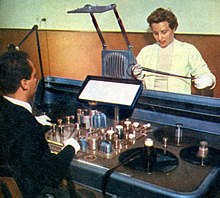Nino Baragli
Nino Baragli | |
|---|---|
 Nino Baragli with his spouse at work in 1957 | |
| Born | Giovanni Baragli 1 October 1925 |
| Died | 29 May 2013 (aged 87) Rome, Italy |
| Occupation | Film editor |
| Years active | 1950–2008 |
Nino Baragli (1 October 1925 – 29 May 2013) was an Italian film editor with more than 200 film credits.[1][2] Among his films in English, The Good, the Bad and the Ugly (1966) and Once Upon a Time in the West (1968), both directed by Sergio Leone, are perhaps the best known.
Born in Rome as Giovanni Baragli, he was introduced in the film industry by his uncle, the renowned editor Eraldo Da Roma. He started his career in 1944 as film operator and assistant editor for Marinai senza stelle by Francesco De Robertis.[3]
During his career he worked as editor in more than 200 productions between 1944 and 1996, including works by
.Collaboration with Pier Paolo Pasolini
The single largest impact of Baragli's editing is likely on the films of
Collaboration with Sergio Leone
Sergio Leone, an Italian director, is best known for five western films from the 1960s and early 1970s that enjoyed international success and established the acting career of Clint Eastwood. Dan Edwards summarized Leone's legacy, writing "Although he remains a controversial figure in critical circles, his stylistic influence is everywhere in '90s American cinema, from Back to the Future Part III (Robert Zemeckis, 1990) to the work of Quentin Tarantino and his associate Robert Rodriguez."[8] Leone's third western was The Good, the Bad and the Ugly (1966), which was co-edited by Baragli and Eugenio Alabiso. Leone had several editors for his films prior to The Good, the Bad and the Ugly; Baragli edited all of Leone's subsequent films. Calling Baragli "Leone's best film editor", Robert Cumbow writes of the 1966 film that "the compelling pace of the film, and the fact that it works so remarkably well, ... is due to Baragli's genius." Leone's last film, released in 1984, was not a western; Cumbow writes of the film that "the time-hopping Once Upon a Time in America is a masterwork of editing."[9] Kenneth Turan concurs, writing "The film slips easily back and forth in time, dancing between the decades, often making the connection from one era to another solely by means of brilliant cuts that work like magic."[10] Stephen Prince wrote "Nino Baragli surpassed even his customary billiance with his editing of Sergio Leone's Once Upon a Time in America, creating a kaleidoscopic narrative that juggled multiple time frames with astonishingly fluid transitions."[11] The film won Leone a nomination for the BAFTA Award for Best Direction.
Final cuts
Baragli won the
Baragli retired from editing in 1996. One of his last projects to be released in the United States was The Monster (1994), which was directed by Roberto Benigni. Baragli had been editing Benigni's films for the previous decade.
In addition to his career as an editor, Baragli was active with the Italian Association of Film Editors (Associazione Montaggio Cinematografico e Televisivo (A.M.C.)) and served as its president for a time in the 1980s.[3] In 2012 he received the Lifetime Achievement Award from the organization.
See also
References
- ISBN 9780786476657.
- ^ "Cinema: scomparso lo storico montatore Nino Baragli - Libero Gossip". Gossip.libero.it. Retrieved 2013-06-01.
- ^ ISBN 9781136054105.
Learning how to cut a film is not the same as learning that 2 plus 2 is 4. Sometimes, in film editing, 2 + 2 is 3.
- ^ Moliterno, Gino (December 2002). "Pier Paolo Pasolini". Senses of Cinema (23).
- ^ ISBN 9781623566913.
- ^ Ebert, Roger (March 14, 2004). "Great Films: The Gospel According to Saint Matthew".
- ISBN 9780857730442.
Together with The Leopard, The Gospel According to Saint Matthew is the finest film discussed in this book and one of cinema's few works of art.
- ^ Edwards, Dan (October 2002). "Great Directors: Sergio Leone". Senses of Cinema (22).
- ISBN 9780810860414.
- ^ Turan, Kenneth (10 July 1999). "A Cinematic Rarity: Showing of Leone's Uncut 'America'". The Los Angeles Times.
- ISBN 9780520232662.
The decade also saw outstanding and significant work by the industry's film editors. ... The singular achievements of the decade's filmmaking were often a function of the editor's work. Nino Baragli surpassed even his customary billiance with his editing of Sergio Leone's Once Upon a Time in America, creating a kaleidoscopic narrative that juggled multiple time frames with astonishingly fluid transitions.
- ^ Lancia 1998, p. 275.
- ^ Lancia 1998, p. 268.
- ^ Lancia 1998, p. 279.
- ^ Lancia 1998, p. 250.
Bibliography
- Fawell, John (2005). The Art of Sergio Leone's Once Upon a Time in the West: A Critical Appreciation. McFarland. ISBN 9781476601816. Fawell's book discusses the editing of Once Upon a Time in the West in some detail, with numerous quotes from Baragli.
- Lancia, Enrico (1998). I premi del cinema (in Italian). Gremese Editore. p. 448. ISBN 88-7742-221-1.
- Reale, Giulio (producer and director) (2006). Sergio Leone: The Way I See Things (motion picture). Documentary about Leone that includes interview footage with Baragli.
External links
- Nino Baragli at IMDb
